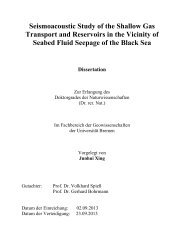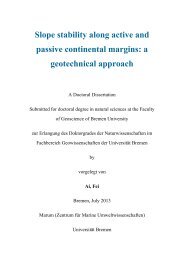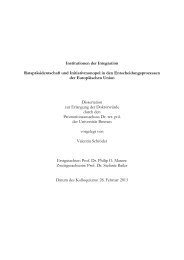Adsorbat-modifiziertes Wachstum ultradünner Seltenerdoxid ... - E-LIB
Adsorbat-modifiziertes Wachstum ultradünner Seltenerdoxid ... - E-LIB
Adsorbat-modifiziertes Wachstum ultradünner Seltenerdoxid ... - E-LIB
Erfolgreiche ePaper selbst erstellen
Machen Sie aus Ihren PDF Publikationen ein blätterbares Flipbook mit unserer einzigartigen Google optimierten e-Paper Software.
Abstract<br />
Rare-earth oxides (REOx) are extensively investigated due to their extraordinary<br />
physical and chemical properties, which essentially arise from the unfilled 4f electron<br />
shell, in order to reveal the nature of these exceptional properties and ultimately to<br />
utilize them for multiple technological applications.<br />
To maintain the exponential increase in integration density in CMOS technology,<br />
which is also known as Moore’s law, there is a strong desire for ultrathin, wellordered,<br />
epitaxial REOx layers with a precisely engineered interface, which is essential<br />
for reliable, ultrahigh-performance devices [2]. So far this has been considerably<br />
impeded by RE-promoted silicon oxidation, leading to amorphous silicon oxide and<br />
RE silicon formation [3].<br />
By using complementary synchrotron radiation methods such as X-ray standing waves<br />
(XSW), X-ray photoelectron spectroscopy (XPS) and X-ray diffraction (XRD),<br />
structural and spectroscopic information are inferred simultaneously from ultrathin<br />
ceria and lanthana films grown on chlorine, silver and gallium passivated silicon(111).<br />
In general, it is revealed that the chemical and structural composition of the interface<br />
and the crystallinity of ultrathin REOx layers on silicon can be precisely controlled<br />
by adsorbate-mediated growth. This might represent a crucial step towards a<br />
perfectly engineered interface, eventually allowing for the integration of REOx as<br />
high-k gate oxides in microelectronics.<br />
In catalysis inverse model catalysts are studied with the aim of getting an in-depth<br />
understanding of the basic principles of catalysis. These model systems are employed<br />
to study, e. g., the nature of active sites and the reaction pathways in complex<br />
catalytic converters. However, a lot remains unknown about the chemical activity<br />
and selectivity as a function of the growth mechanism, structure and morphology of<br />
these model systems.<br />
The powerful spectroscopic photoemission and low-energy electron microscope, which<br />
is able to reveal the surface structure and chemical composition at nanometer resolution,<br />
is used to shed light on the growth, morphology and oxidation state of the<br />
inverse model system ceria on ruthenium(0001) up to very high growth temperatures<br />
of 1000 ℃. It is revealed that ceria on ruthemium(0001) forms a commensurate<br />
phase. Specifically, it is shown that the ceria island size and nucleation density can<br />
be adjusted by appropriate growth conditions, potentially giving the ability to tailor<br />
the reactivity of the catalyst through precise structural control.<br />
vii
















